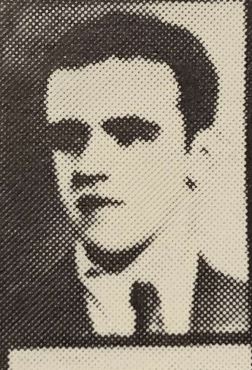
brochure "Partizanski spomenik u Mostaru" (1980)
book “Spomenica Mostara 1941-1945.”
another document or proof of the memorial stone (e.g., a photograph).
Šefko M. FEJIĆ
ŠEFKIJA ŠEFKO FEJIĆ, son of MUHAMED, born on October 8, 1915, in Mostar. He was a student of architecture in Belgrade and had excellent knowledge of the French language. He became a member of the Communist Party of Yugoslavia (KPJ) in 1940. He was arrested by the Italians and interned in the Mamula camp. His mother, Adila, recounted, “They came to take Šefko away while he was asleep. They didn’t knock, they jumped over the wall and took him. That happened during the assassination of Jevđević, and he never returned. I went to see him in Zelenik, the Italian prison. I cooked something and brought it to him.” He was released after Italy’s surrender. He joined a partisan unit in the autumn of 1943. As a fighter, he died in battles near Bileća in August 1944. According to F. Buturović, “He was captured by the Chetniks on Modropec while on guard duty… Two days later, they found his body parts on the wire… We could barely recognize him, and it was even harder to bury him…”
One of the five deceased members of this family, four brothers and one sister: Džemal, Ešref, Esad, Samija. Both of Šefko’s uncles were killed by the Germans (one of them is Dr. Asim Opijač). One of the most famous streets in Mostar is named after the Fejić brothers. The well-known song “Mostarska mati” by Mostarske kiše is dedicated to Šefko’s mother, Adila Fejić. In 1972, Mišo Marić published an interview with Adila, which you can read here.
EXCERPTS FROM LITERATURE:
Member of SKOJ and a former prisoner from Mamula, Fadil Buturović, recalled their time spent with Šefko:
“I met Šefko Fejić in the concentration camp Mamula, an old French fortress – a small island at the entrance to the Bay of Kotor – to the extent that prisoners can get to know each other after spending days and months in the same cell. He was the leader for me and three other Mostar residents, serving as a link to the underground leadership of the camp. We shared the hardships of imprisonment, hunger, poverty, worries, small joys, and hopes – the last sip of a lean soup with a rare piece of macaroni, the daily ration of ten decagrams of bread, a green carob picked while working, remains of moldy food scavenged from the camp kitchen dump or from the harbor where we unloaded supplies and mail from Herceg Novi.
I also remember his story about meeting my mother in the women’s section of the camp. He spoke French, learned Italian, and served as a translator for the camp administration. (…) He loved me. He protected me as much as he could. He took my place for harder work assignments. He spoke to me as an equal. I felt his protective hand; I could always rely on it – the firm, dear hand of a friend.”
Mahmud Konjhodžić briefly described Šefko’s capture and death in his short review “Heroic Mothers and Their Children: Adila”:
“When they came for her son Šefko, an architecture student, the house was surrounded by Chetniks and Italians. (…) While he was sleeping, they captured Šefko and took him to prison, then to the Dubrovnik fortress of Lovrijenac, converted into a prison, and finally to a camp in Italy. After the capitulation of fascist Italy, he returned to Mostar and died as a partisan somewhere near Bileća.”
Konjhodžić, Mahmud (1981): “Mostarke”: fragmenti o revolucionarnoj djelatnosti i patriotskoj opredjeljenosti žena Mostara, o njihovoj borbi za slobodu i socijalizam, Opštinski odbor SUBNOR-a Mostar, str 232; https://poskok.info/mostarke-u-doba-okupacije-sloboda-nije-stigla-iz-bajke/; Džemil Šarac, članak „Sa Mostarcima“, Hercegovina br 9, str 221; grupa autora: Spomenica Mostara 1941-1945; članak “Majka iz ulice sinova”, autor: Mišo Marić, list “Sloboda” 1972. (ustupio CIDOM); Buturović, Ferid (2016): Kuća mostarskog kadije, sjećanja skojevca – ilegalca i partizana, Sarajevo.
Fotografija: S. Demirović
Do you have more information about this fighter? Share your stories and photographs. Let's keep the memory alive!



